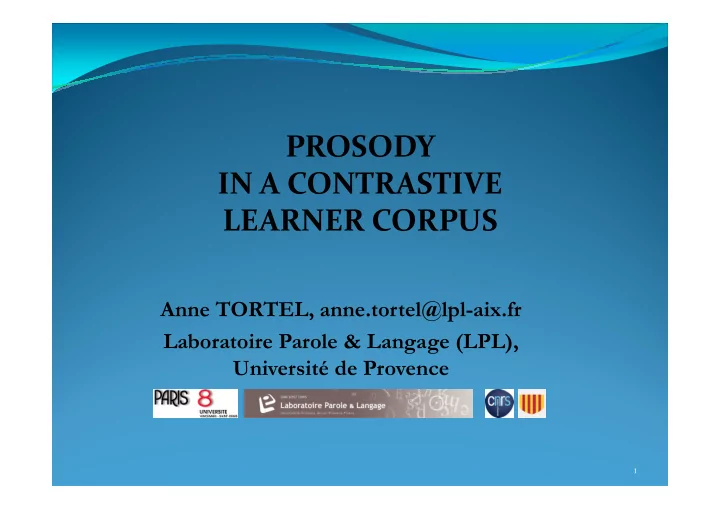

PROSODY IN A CONTRASTIVE LEARNER CORPUS ����������������������������������� ������������������������������������ ��������� !� ������"� 1
� Introduction � 2 topics: corpus ANGLISH • (Tortel, A. - TIPA, 2008) results of a study on English rhythm of French • learners � Conclusion & perspectives 2
Difficulties in acquiring English rhythm � difficulties in acquiring English rhythm are due to several factors (Adams, 1979) observation of the difficulties of L2 non native speakers of English : � insufficient durational difference between unstressed and stressed syllables � unstressed syllables are not reduced appropriately � misplaced stress 3
Can it be applied to a French speaker? comfortable vs comfortable ! 0,13 ms 0,24 ms 4
Prosodic transfer � �����!�"�������������#��$�����%� ������������� &'�����(� �)�� ���* �� ���� ��� ����+��� ���")���� �( "�#������ "�#������ �)� �)� ������������ ������������ "��������� "��������� ��! ��! �)��� �)��� �����,������ �� �)� ������ ����+����� �)�( "�� ��� !�-� �)� ��+�"�� �� �����!�" ����������"� ��! ��������.� Influence of L1 rhythm (French) on the rhythm of L2 (English) 5
ANGLISH � comparative database of English spoken by: -natives of British English -French learners of English � 63 speakers recorded in an anechoic room (LPL) � 3 groups : -23 natives of British English - 20 second or third-year French students of English at university English at university -20 French speakers, non specialists in English, workers, and desirous to improve their English � 3 different tasks : -reading 4 passages (from EUROM1) -repeating sentences after a native model -speaking on a free subject for about two minutes (monologue) 5.30 h of spoken English L1 & L2 6
ANGLISH: design & advantages • compensate for a lack of corpus in English L1 & L2 by French learners (freely distributed) • can be used for different purposes of research • contains : * diverse types of exercices * diverse levels of French learners * diverse levels of French learners • good quality of recordings � being under manual segmentation ( IU, words, syllable, anacrusis and phonemes) � is freely available on the CRDO website http://crdo.up.univ-aix.fr/ 7
ANGLISH: transcriptions & segmentations of the reading part 8
ANGLISH: extracts � Task 1: Reading FR1 GB • FR2 � Task 2: Repeating sentences � Task 2: Repeating sentences Model FR1 � Task 3: Monologue on a free subject FR1 FR2 GB 9
ANALYSES: ENGLISH RHYTHM � Study investigation of rhythmic parameters in the production of French learners of English and British native speakers � Purposes to examine the utility of recently- developed rhythm metrics of speech developed rhythm metrics of speech to evaluate the tendancy of the rhythm productions of French learners of English � Final aim to search for acoustic prosodic criteria in order to develop an objective and automatic evaluation for the French students’ productions in English 10
METHOD: rhythm metrics Metrics measure the degree of variability between vocalic & consonantal intervals durations � Metrics calculated with a PRAAT script ( Daniel Hirst ) 11
METRICS USED % V sd (C,V) rPVI (C,V) nPVI (C,V) Cv(C,V) Dellwo Ramus & al. (1999) Grabe & Low (2002) (2006) White & Mattys (2007) Normalised Normalised Raw index index of Standard variability coefficient of variability % duration of deviation of between variation of between vocalic duration of duration of duration of duration of intervals cons. & voc. successive cons. & voc. successive intervals cons. & voc. intervals cons. & voc. intervals intervals take into account 12 speech rate
MAIN HYPOTHESIS � INTERLANGUAGE DISCRIMINATION � INTERDIALECT DISCRIMINATION IS L1/L2 DISCRIMINATION POSSIBLE ? 13
Method: corpus � The reading part of the corpus ANGLISH: 1.30 h Segmen- tation in CVC 14
THE RESULTS the better the non native speakers’ the better the non native speakers’ productions and the closer to an English rhythmic structure the rhythm is, the closer to the native speakers the results would be. 15
L1 RHYTHM IMPACT ON L2 PRODUCTIONS? HYPOTHESIS VALIDATED WITH WITH NORMALISED METRICS (nPVI_V, nPVI_C) – (cvV, cvC) 16
TO WHICH GROUP THE SPEAKERS BELONG TO? AIM Characterizing the different groups of speakers according to 3 levels: FR1 = learners with low level of English FR2 = students of English at university GB = native speakers 17
DISCRIMINANT ANALYSIS REAL PREDICTED GROUPS GROUP FR1 FR2 GB (%) FR1 69% 25% 6% FR2 25% 50% 25% GB 6% 22% 72% A THREE WAY CLASSIFICATION OF SPEAKERS 18
CONCLUSIONS � 1. It is possible to discriminate L1 from L2 rhythmic productions and to see the influence of the mother language to the target language language to the target language � 2. It is possible to classify the productions of the speakers into different levels 19
PERSPECTIVES � Work on spontaneous speech (monologues) � Use of other metrics / methods � Enlarge the study to ripen the evaluation � Subjective evaluation/perception test of the productions 20
PERSPECTIVES: ANGLISH � Improvement of the phonemic transcription � Segmentation of the monologues � Creation of FRANGLISH ! 21
22
Recommend
More recommend